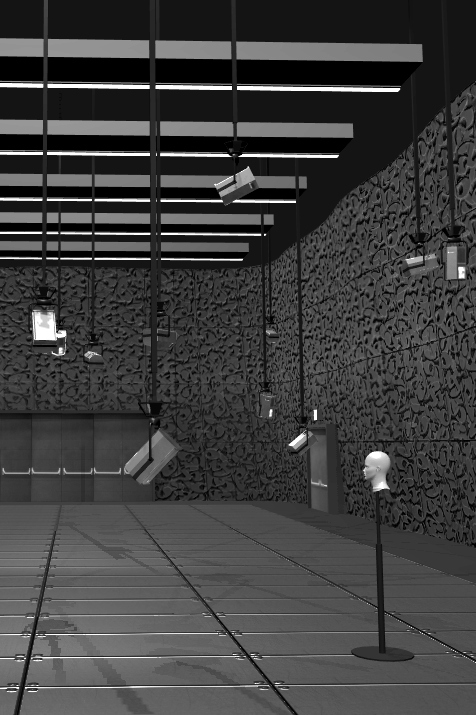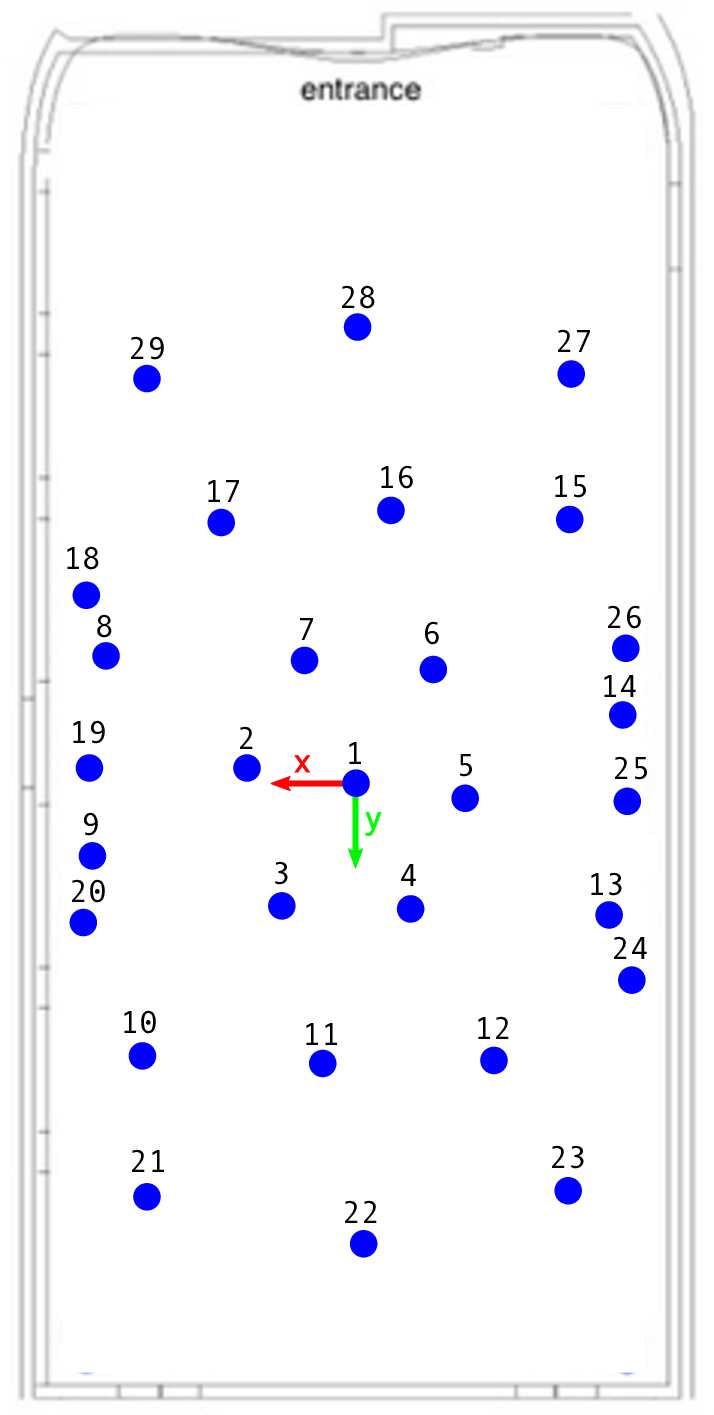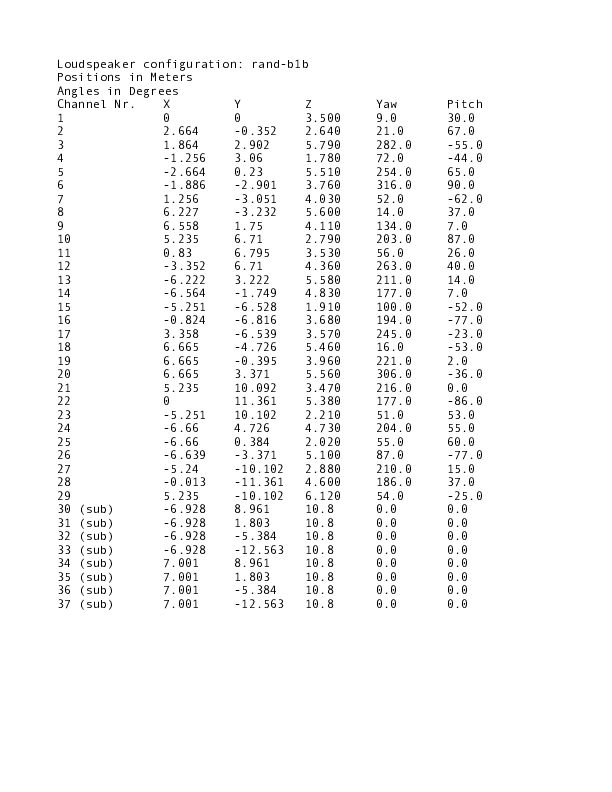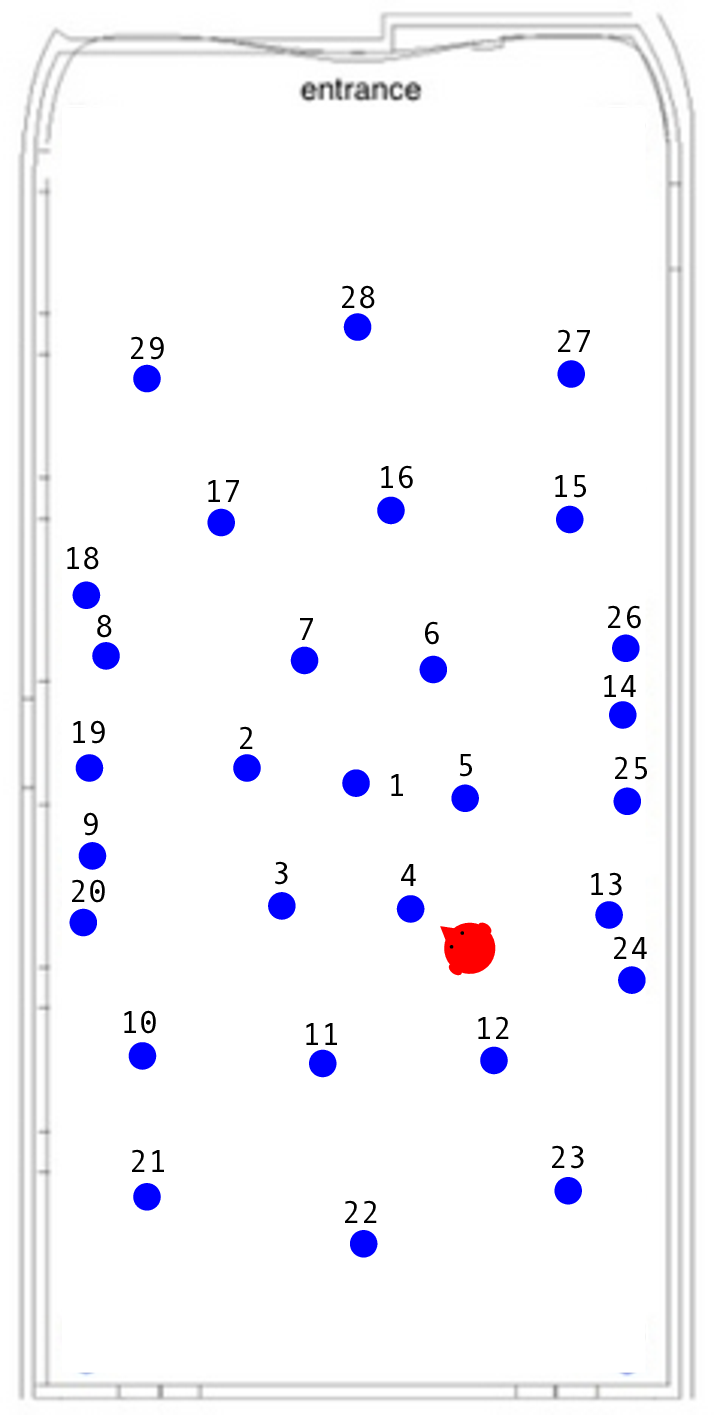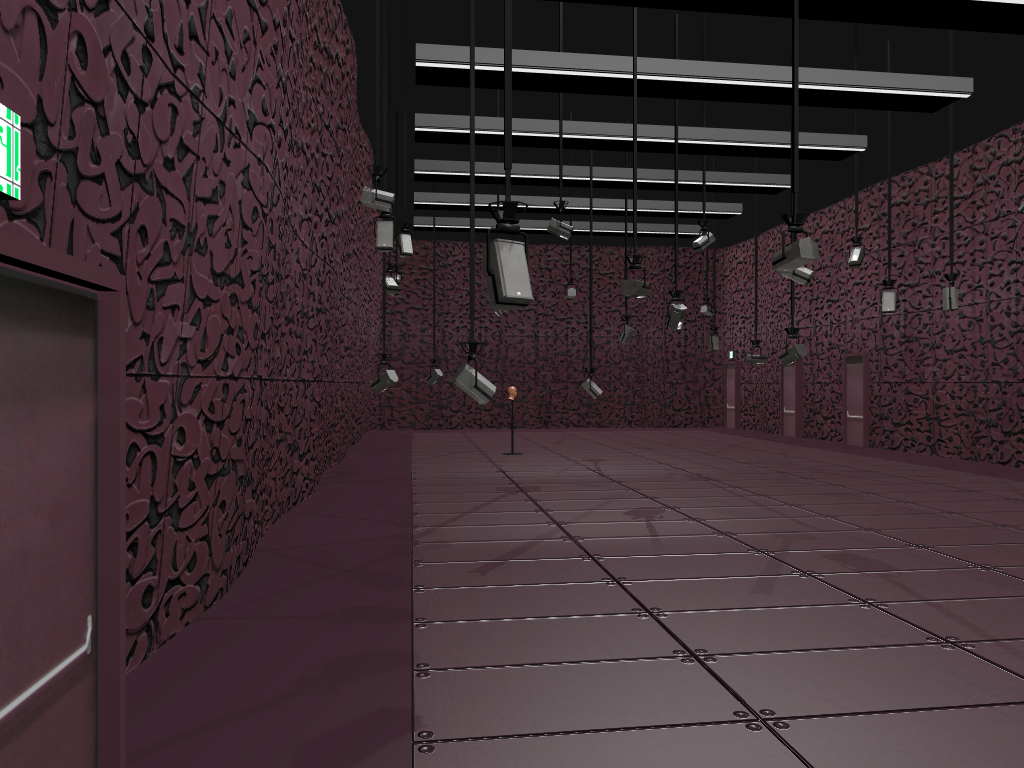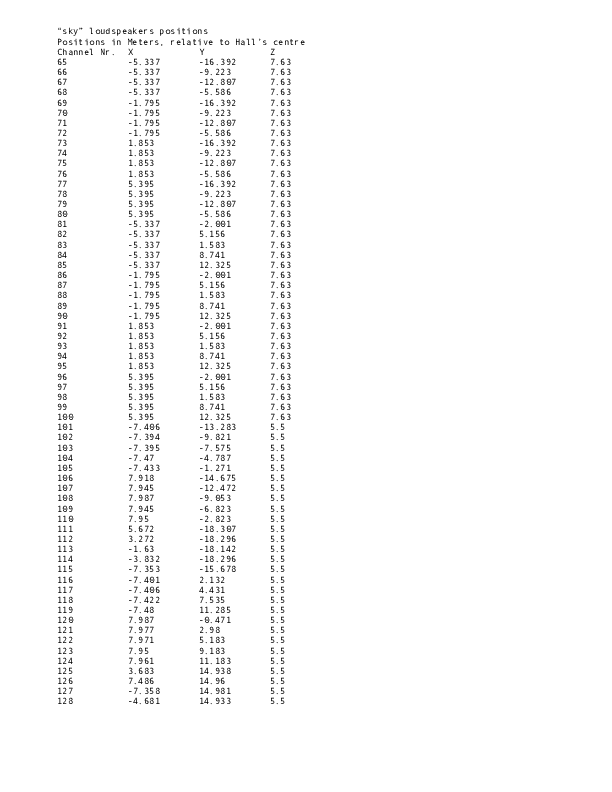Special Call : Works for MUMUTH - Ligeti Hall
xCoAx 2020 will be hosted by the University of Music and Performing Arts Graz (KUG) and the Institute of Electronic Music and Acoustics (IEM) and will take place in the MUMTUH building (House of Music and Music Theatre). The venue contains various spaces and in particular the Ligeti Hall, the University's main stage, where part of the xCoAx 2020 performances will take place.
The Ligeti Hall is a ca. 500 square metres concert hall provided with state-of-the-art technology in particular for sound and video projection. Its floor consists of a series of pedestal elements that, by means of individual motors, can be positioned at different heights in order to realise adaptable topologies. The hall is equipped with a system of 29 loudspeakers mounted on independent, custom made motorised suspensions, which allow to adjust height level, azimuth angle and tilt of each individual speaker and to compose custom speaker layouts. Further, an array of 64 speakers, which may be addressed individually, spans the hall's entire ceiling and upper walls.
This is a call for works which are especially tailored towards the Ligeti Hall's special infrastructure and its possible aesthetic implications. In particular, we seek contributions with a strong experimental and electroacoustic character that challenge common and established approaches to sound on multichannel setups, pieces that engage in an exploratory mode pursuing the unexpected rather than relying on trodden paths.
In order to help potential applicants in the process of developing and shaping their contributions, we provide detailed information regarding the technical setup along with special tools for binaural auralisation of the hall's loudspeaker setup, offering the means to construct a simulated perceptual image of the space. Find more details at the bottom of this page.
If you have any questions regarding this call or would like to have more detailed information, do not hesitate to contact us directly at <pirro@iem.at>.
Submission
Submission to this category follows the same procedure as the other xCoAx 2020 categories. Submit a 3 to 4 page description paper, following the formatting in the Word template. Revision of proposals will be single-blind. Proposals should provide a clear description of the work, one or more URLs for access to relevant media assets, and a technical rider (layout, setup, required equipment). The acceptance of performances will not only depend on reviews, but also on their technical requirements. xCoAx has a limited budget, mainly based on the registration fees. Works that require excessive resources on xCoAx’s part may not be accepted. It is fundamental that the proponents are ready to bring their own equipment and minimize their reliance on the xCoAx organisation. All accepted works will be allotted 5 minutes presentation time at the conference. Performances will be allotted a maximum of 20 minutes on stage during the performance night. The proceedings will publish an extended abstract to be provided by the authors after the conference.
- Applicants may provide one mono-channel file for each used loudspeaker channel (please clearly describe the loudspeaker to file mapping).
- Alternatively applicants may send their piece in a Higher Order Ambisonics (HOA) encoded sound file, with format specifications.
- We specially encourage submission of generative works. In particular, works for open source environments such as Pure Data or SuperCollider, configured with instructions for performance are welcome. If other programming languages or environments are used, please include as detailed as possible instructions for how the code should be run.
Applicants may choose one of the two provided arrangements for the 29 motorized loudspeakers (configuration of height, pitch and yaw) or may compose (within the Ligeti Hall's system limits) a special arrangement. In any case, submissions must include a clear description of the loudspeaker positions.
All works must be submitted via EasyChair.
Submission deadline: JANUARY 31; Extended: FEBRUARY 16
Technical Details
The Ligeti Hall has a total of 101 loudspeakers:
- the so-called "sky": an array of 64 speakers spanning the hall's entire ceiling and upper walls
- 8 subwoofers, installed on the ceiling and arranged in 2 groups of 4
- 29 movable speakers.
The 29 moveable speakers are mounted on independent, custom made motorised suspensions. Thus, for these speakers, it is possible to adjust the height level (the z coordinate), azimuth angle and tilt individually and compose different speaker arrangements.
Auralisation
With this infrastructure, the Ligeti Hall allows for the most diverse approaches to the composition of space and/in/with sound. However, it can be clearly very difficult for composers and sound artists to make full use of this flexibility if they have no direct access and experience of the acoustics of the hall.
Therefore, using binaural auralisation techniques, we try to provide the means for applicants to this category to gain a perceptual experience of the Ligeti Hall's acoustics and to test how their works would sound in the Hall (with approximation).
A good way to get familiar with binaural auralisation in the Ligeti Hall is to visit the page Intro to Auralisation which was used in the Mind the Gap Symposium to document the space and its technical setup.
The tools we are using in the auralisation involve the digital audio workstation Reaper (available for download for all major operating systems for free here) in combination with the plugin suite mcfx multichannel audio plug-in suite by Matthias Kronlachner (available for download for macOS and Windows here *). Both of these tools have to be installed on your machine.
* we apologise, the plug-in suite is currently not available on Linux. If this is a problem, you may get in touch to see if we can set you up with Reaper and JConvolver.
Reaper Setup
We provide different Reaper projects which binaurally simulate three different speaker configurations:
- hemiaux: simulates the 29 loudspeakers in a hemispherical configuration ("classical" dome arrangement used e.g. for ambisonics spatialisation), all facing the centre of the hall, plus the 8 subwoofers.
- rand-b1b: 29 loudspeakers, each one with random height, azimuth and tilt, plus the 8 subwoofers.
- sky: simulates the 64 channels sky.
For each loudspeaker configuration, two listening positions are available (see images on the right): one in the middle of the hall (center), and a second one a bit more off-centred towards loudspeaker number 4 (vierdirekt). The next steps describe how to setup the mcfx convolver plugins with Reaper, and how to configure it to work with the Ligeti Hall impulse responses in Windows and macOS.
STEP 0 - Download everything you need:
- download Reaper: https://www.reaper.fm/download.php
- download mcfx plugins by Matthias Kronlachner: http://www.matthiaskronlachner.com/?p=1910
- download convolver presets and Reaper projects from here.
STEP 1 - Install Reaper
STEP 2 - Install plugins:
- (macOS) extract the folder named "mcfx_v0.5.7_osx_vst.zip" in folder "~/Library/Audio/Plug-Ins/VST". If folder doesn't exists, create it.
- (Windows) run "mcfx_v0.5.7_win64.exe" and follow instructions.
STEP 3 - Setup convolver:
- (macOS) Put the content of folder "conv_presets" in folder "~/Library/mcfx/convolver_presets". If folder doesn't exists, create it.
- (Windows) Put the content of folder "conv_presets" in folder "C:\users\USER\AppData\Roaming\mcfx\convolver_presets", replace USER with your username. If folder doesn't exists, create it.
At this point, you should be set. Go to folder "channel_test_templates" and open any .RPP file to launch a Reaper project where you can test your configuration. The folder contains six .RPP files, where you can test any speaker setup (hemi, random or sky) from the two different listening points (center or vierdirekt) we provide. To start an empty project with your desired configuration go to folder "templates" and open the corresponding Reaper project.
In each of the Reaper projects, the tracks labelled with "channel N" corresponds to one loudspeaker channel in that configuration. For instance, open the project named, "template_rand_vierdirekt"; place a sound file of on track "channel 13"; then start playback and listen through headphones. What you would hear is a binaural rendering of the sound track "as if" it would be played through loudpspeaker number 13, with you sitting in the Ligeti Hall in the position "vierdirekt", the loudspeakers in the rand-b1b positions.


